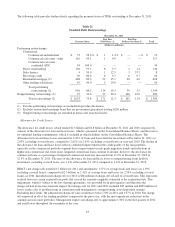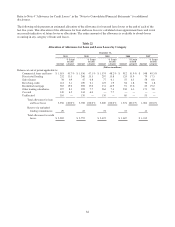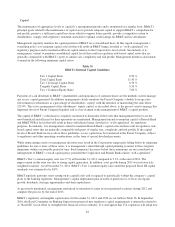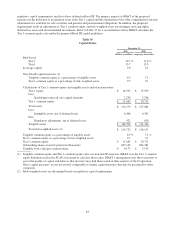BB&T 2011 Annual Report Download - page 73
Download and view the complete annual report
Please find page 73 of the 2011 BB&T annual report below. You can navigate through the pages in the report by either clicking on the pages listed below, or by using the keyword search tool below to find specific information within the annual report.
•Secondary sources of repayment—alternative repayment funds are a significant risk-mitigating factor as long as
they are liquid, can be easily accessed and provide adequate resources to supplement the primary cash flow
source.
•Value of any underlying collateral—loans are generally secured by the asset being financed. Because an analysis
of the primary and secondary sources of repayment is the most important factor, collateral, unless it is liquid,
does not justify loans that cannot be serviced by the borrower’s normal cash flows.
•Overall creditworthiness of the customer, taking into account the customer’s relationships, both past and current,
with other lenders—BB&T’s success depends on building lasting and mutually beneficial relationships with
clients, which involves assessing their financial position and background.
•Level of equity invested in the transaction—in general, borrowers are required to contribute or invest a portion of
their own funds prior to any loan advances.
Commercial Loan and Lease Portfolio
The commercial loan and lease portfolio represents the largest category of the Corporation’s total loan portfolio. BB&T’s
commercial lending program is generally targeted to serve small-to-middle market businesses with sales of $250 million
or less. In addition, BB&T’s Corporate Banking Group provides lending solutions to large corporate clients. Traditionally,
lending to small and mid-sized businesses has been among BB&T’s strongest market segments.
Commercial and small business loans are primarily originated through BB&T’s Community Bank. In accordance with the
Corporation’s lending policy, each loan undergoes a detailed underwriting process, which incorporates BB&T’s
underwriting approach, procedures and evaluations described above. In addition, Branch Bank has adopted an internal
maximum credit exposure lending limit of $245 million for a “best grade” credit, which is considerably below Branch
Bank’s maximum legal lending limit. Commercial loans are typically priced with an interest rate tied to market indices,
such as the prime rate and the London Interbank Offered Rate (“LIBOR”), or a fixed-rate. Commercial loans are
individually monitored and reviewed for any possible deterioration in the ability of the client to repay the loan.
Approximately 90% of BB&T’s commercial loans are secured by real estate, business equipment, inventories and other
types of collateral.
In the normal course of business, residential acquisition, development and construction, commercial construction or
commercial land/development loan agreements may include an interest reserve account at inception. An interest reserve
allows the borrower to add interest charges to the outstanding loan balance during the construction period. Interest
reserves provide an effective means to address the cash flow characteristics of a real estate construction loan. Loan
agreements containing an interest reserve generally require more equity to be contributed by the borrower to the
construction project at inception. Loans with interest reserves are subject to substantially similar underwriting standards as
loans without interest reserves.
Loans with interest reserves are closely monitored through physical inspections, reconciliation of draw requests, review of
rent rolls and operating statements and quarterly portfolio reviews performed by senior management. When appropriate,
extensions, renewals and restructurings of loans with interest reserves are approved after giving consideration to the
project’s status, the borrower’s financial condition, and the collateral protection based on current market conditions. In
connection with the extension, renewal or restructuring of a loan with an interest reserve, additional interest reserves may
be funded by the client, partially funded by the client and BB&T, or fully provided by BB&T. Typically, interest reserves
provided by BB&T are secured by additional collateral and are limited to more conservative advance rates on the pledged
collateral. These loans must also be supported by an analysis of the client’s willingness and capacity to service the debt.
Interest that has been added to the balance of a loan through the use of an interest reserve is recognized as income only if
the collectability of the remaining contractual principal and interest payments is reasonably assured. If a loan with interest
reserves is in default and deemed uncollectible, interest is no longer funded through the interest reserve. Interest
previously recognized from interest reserves generally is not reversed against current income when a construction loan
with interest reserves is placed on nonaccrual status.
At December 31, 2011, approximately $680 million of BB&T’s construction loan portfolio have active interest reserves
(i.e., current funding of interest charges through a reserve) compared to $1.2 billion at December 31, 2010. Interest
income related to loans with active interest reserves was approximately $30 million and represents less than 1% of total
interest income for the year ended December 31, 2011.
73
























